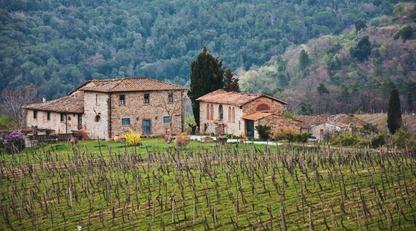Italian wine is increasingly becoming hot property when it comes to wine investment. Last year was one of the category’s strongest when it came to trades, with an increase of 7%. Tuscany also performed remarkably well and, because of this, we have put together a list of Tuscan wines that are highly respected, built to age for years and that are leading the charge when it comes to investment grade wine.
The classic ‘Super Tuscans’ – including producers such as Solaia, Ornellaia and Tignanello (all having increased in trades in 2020 by 15%, 10% and 9% respectively) – began making incredible wines in the 1960s and 70s. These producers created standout wines using Bordeaux grape varieties and paved the way for others who are now gaining more and more recognition using other grape varieties, including Sangiovese.
Tua Rita is widely regarded as the producer who spearheaded the second wave of Super Tuscans, with its flagship wine Redigaffi. Like some of the greatest things in life, Redigaffi was created entirely by accident. In 1984, Rita Tua and her husband Virgilio moved to the quiet Etruscan coast to retire and cultivate wines for fun. Years later, and with 30 hectares of Merlot under vine, Redigaffi is now considered one of Tuscany’s finest wines that commands respect. This wine continues to gain momentum and we believe it would make an excellent investment option for those wanting to diversify their portfolio.
Second on our list of Tuscan wines is the top-flight Chianti producer Fontodi. Keeping a steady hand on the tiller at the Fontodi estate are Marco and Giovanni Manetti who have been making its predominantly Sangiovese-based wines since 1979. Their vision, expertise and commitment to quality continue to reap rewards: Fontodi’s Flaccionella della Pieve 2017 was one of last year’s top ten most-traded Tuscan wines & in the top 15 most-traded Italian wines. It represents a great diversification into a wine investment category that’s accelerated in the past 12 months.
Biondi Santi is one of the old, traditional Tuscan wine estates whose pioneering work propagating the Biondi Santi Brunello di Montalcino clone of Sangiovese cemented it as one of the region’s legendary producers. As perhaps the greatest expression of Brunello di Montalcino, this 100% Sangiovese wine aged for at least 36 months in oak is built to last for decades, if not longer. With the Riserva 2012 having all three ingredients that we would expect to appreciate: a historic brand, immense ageing potential and one of their highest ever scores – 97 points – it offers excellent value compared to top tier wines from other regions.
If you want to find out more about investing in Italian wines – and the growing Tuscan category in particular – schedule a free consultation with one of our investment experts.


